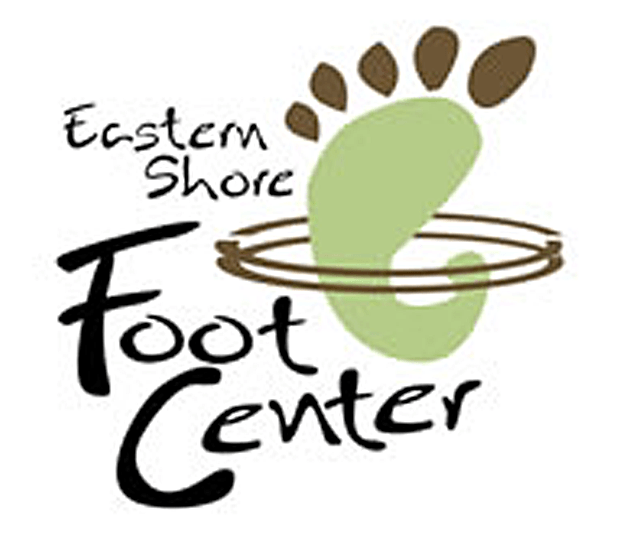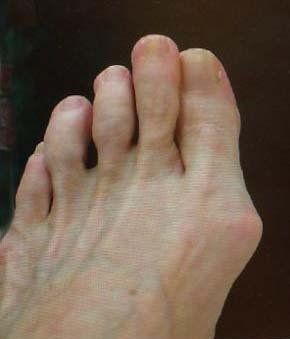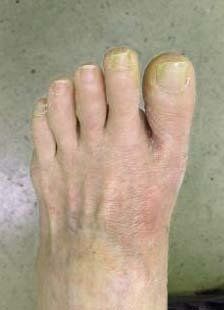Treating a Variety of Foot Problems
Over 40 Years of Experience | Wide Range Of Treatment Options | Traditional & Minimally Invasive Surgery
Over 40 Years of Experience
Wide Range Of Treatment Options
Traditional & Minimally Invasive Surgery
We Can Treat A Wide Range of Foot Conditions
At Eastern Shore Foot Center PC, we treat a wide range of foot deformities and problems. Don't live with foot pain. Talk
to us today!
- Bone spurs
- Bunions
- Corns and calluses
- Diabetic foot care
- Foreign bodies
- Gout
- Hammertoes
- Heel pain
- Nails
- Neuroma
- Warts and soft tissue
Bone Spurs
Bone Spurs are simply an enlargement of bone, which can happen anywhere in the body. They may form due to arthritic changes, injury, constant pressure, or genetics.
Often, they cause no discomfort, but when they rub on a nerve or cause a joint to ache, treatment may be necessary. Anti-inflammatories either topically or orally may give some relief. Injections of steroids may give months if not years of pain reduction.
Surgical excision is recommended for long-term relief. Surgery consists of reducing the spur through a procedure called osteotripsy. This involves the use of a small bone cutting burr directly onto the bone, which grinds it into a paste that is expunged from the small incision site.
Heel spurs are falsely considered the cause of the heel pain. They are not! The thickening of the plantar fascia, which is the connective tissue under the foot is the cause of the pain. Many patients with heel pain have spurs, but they are not the cause of heel pain.
Bunions
There are many different levels of the bunion deformity. Surgery reduces the enlargement of the bone and repositions the bones into proper alignment. This can be done without internal fixation in many cases.
Bunion pain can be arthritic and is often relieved with a steroid injection or anti-inflammatory medications. Changes or modifications to shoes can be beneficial in alleviating pain when surgery is not an option.
Functional orthotics with certain modifications can delay and reduce both the bunion formation and the pain associated with this condition. It is important to understand that bunions are inherited. In most cases, they can not be avoided if they run in the family.
Juvenile bunions are seen in young children, usually by the age of 12. Children with bunions may eventually need surgery. We do not recommend bunion surgery on children since their bones are still developing and growing. Orthotics with modifications is the best treatment for children.
Corns and Calluses
Corns form on toes over a bony prominence due to friction. Calluses are similar, and they are formed from friction but usually on the sole of the feet. Both the conditions are only temporarily relieved with debridement.
For permanent relief of corns, surgery is required, which would involve removing the bony prominence.
Calluses are formed under the ball of the foot. The pathology could be a dropped metatarsal head or thinning of the fat pad that allows the bone to rub when walking.
Sometimes, just a soft insole can alleviate the discomfort. A change of shoes may be all that is required, but there are permanent surgical options available depending on the location and severity of the lesion.
Diabetic Foot Care
Diabetes is a metabolic disorder that has been rising around the world in rapid numbers. This disease, regardless of severity, can affect every organ in the body, including blood vessels and nerves.
Diabetics are more prone to infection due to changes in their blood chemistry. Neuropathy, which is small fiber nerve damage, usually begins as a burning or tingling sensation in the feet starting in toes and slowly working its way into the lower legs.
A simple ingrown nail can become a life-threatening infection to diabetics due to the inability to sense the pain, detect the spread of infection into bone, as well as the poor ability to heal. Most diabetics are unique and face different challenges, but if addressed early, many problems reverse before they become devastating.
Foreign Bodies
When a foreign object such as glass or metal gets embedded in the bottom of a foot, pain and infection usually occur. Removing these objects, deep within the soft tissue, will require the use of radiographs, fluoroscopes, or ultrasounds.
Having these diagnostic aids available helps reduce the size of the incision, time, and complexity of the procedure. If the object is superficial such as a small splinter, tweezers may be all that’s required.
Gout
Gout is a metabolic disorder that causes severe pain in a joint. Pain comes on suddenly and the area of pain is usually red, hot, and swollen. The pain is not alleviated by rest.
This condition is treated with medications, injections, and changes in eating habits. If you feel that you are experiencing a gout attack, please call our office.
The pain without treatment can last 2-3 weeks and is quite debilitating. You will require a prescription to buy the medications needed to treat this condition. Our doctor can help reduce your gout pain rapidly. We also offer both holistic and prescription treatments that can reduce frequency and severity.
Hammertoes
Hammertoes are digital deformities that often become painful over time. Treatment depends upon the extent of the changes to the toes. Both conservative and surgical corrections will alleviate the problem.
Surgery can be as easy as a tendon release that requires minimal downtime and often little to no pain. If the toe is non-flexible, then bone removal is required. Depending on the deformity and which toes are involved, this is often corrected without pins and screws that can cause infections, permanent stiffness, and complications that may require additional surgery.
Heel Pain
The most common heel pain is due to a condition called plantar fasciitis. The pain that occurs with this disorder is typically felt directly under the heel.
The pain is quite severe upon initial ambulation after rest. Most people, but not all, experience a sharp stabbing pain with the first step in the morning, which eases slightly with walking.
There are many misconceptions when it comes to the treatment of plantar fasciitis.
The exercises that most doctors recommend usually cause the condition to worsen if the fascial band (the connective tissue under the foot related to this condition) has been enlarged. Stretching it further can make the condition much worse.
It should not take months or years to correct. Proper treatment can give immediate relief or at least reduction in pain. The vast majority of people suffering from this condition receive treatments with changes in shoes, functional orthotics, night splint, injections, and taping. If left untreated, it can get worse and require surgical correction. The faster this condition is treated, the faster it can be reversed.
Nails
There are many problems with toenails ranging from discoloration, thickening, fungal and bacterial infections, injuries, and ingrown nail disorders. Treatments vary depending on the patient and conditions.
Most ingrown nails are very painful. If left untreated, this can lead to osteomyelitis, which is a bone infection. A simple in-office procedure, called a partial matrixectomy, often alleviates ingrown nail problems for life.
In the vast majority of cases, the patient can resume all activities, including sports, within a day of undergoing this nail correction. Maintaining normal appearance to the toe is important, and only the ingrown section of the nail is removed.
Discoloration of the nail can be due to dried blood under the nail, or the beginning of a fungal infection. Unfortunately, it can also be as devastating as a melanoma.
Thick, crumbly nails are typically due to fungal infections. Treatments include a reduction of the nail for comfort or medications to eradicate the infection.
If you notice changes in your toenails, or you are experiencing pain in a nail, you need to make an appointment.
Neuroma
A neuroma is an enlargement of a nerve and can occur anywhere in the body. Morton’s Neuroma is a common painful nerve condition of the foot. The radiating pain associated with this condition typically occurs during walking. It has been described as the feeling of a hot poker running into the foot and shooting into the toes. Before the severe radiating pain, patients typically experience a simple tingling or numbing sensation as if their socks are bunched up under the ball of their foot.
Treatment depends on the severity and frequency of the pain. When treated early, shoe modifications or functional orthotics may be all that’s needed. If the problem is persistent, then injections or surgery may be required. The surgery is performed in the office and takes about an hour. The patients are only in bandages for approximately 2 weeks.
Warts and Soft Tissue
The term plantar wart refers to a common viral lesion that forms on the bottom (plantar surface) of the foot. Verruca is the medical term for warts, and they can appear anywhere on the body. They are all just warts. There is a multitude of similar lesions that resemble warts. Many of these can be treated in a similar manner.
Often the only distinguishing feature of a wart is the “black dots" that people often wrongly refer to as seeds. These speckled areas are actually dried blood.
Warts are very vascular with tiny capillaries. When these areas are trimmed, they will show pinpoint bleeding which will dry as tiny black dots.
There are dozens of treatments available, and most work to a limited degree. Radiowave burns and topical medication dissolves the warty type growths. Each treatment is used, depending on the size, location, and history of reoccurrence. Unfortunately, there still is no oral medication like an antiviral that seems to work.




Share On: